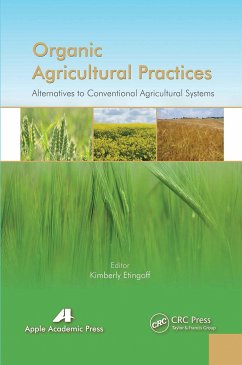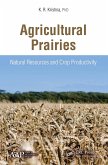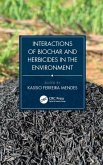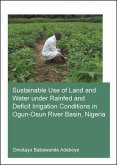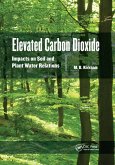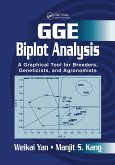Organic Agricultural Practices
Alternatives to Conventional Agricultural Systems
Herausgeber: Etingoff, Kimberly
Organic Agricultural Practices
Alternatives to Conventional Agricultural Systems
Herausgeber: Etingoff, Kimberly
- Broschiertes Buch
- Merkliste
- Auf die Merkliste
- Bewerten Bewerten
- Teilen
- Produkt teilen
- Produkterinnerung
- Produkterinnerung
This title includes a number of Open Access chapters. Organic practices are quickly redefining how agriculture is done around the world, as we come to realize how detrimental conventional agriculture is to local and global environments and economies. This book serves as an overview of some of the important topics in organic
Andere Kunden interessierten sich auch für
![Agricultural Prairies Agricultural Prairies]() K R KrishnaAgricultural Prairies103,99 €
K R KrishnaAgricultural Prairies103,99 €![Interactions of Biochar and Herbicides in the Environment Interactions of Biochar and Herbicides in the Environment]() Interactions of Biochar and Herbicides in the Environment93,99 €
Interactions of Biochar and Herbicides in the Environment93,99 €![Innovations in Micro Irrigation Technology Innovations in Micro Irrigation Technology]() Innovations in Micro Irrigation Technology103,99 €
Innovations in Micro Irrigation Technology103,99 €![Sustainable Use of Land and Water Under Rainfed and Deficit Irrigation Conditions in Ogun-Osun River Basin, Nigeria Sustainable Use of Land and Water Under Rainfed and Deficit Irrigation Conditions in Ogun-Osun River Basin, Nigeria]() Omotayo Babawande AdeboyeSustainable Use of Land and Water Under Rainfed and Deficit Irrigation Conditions in Ogun-Osun River Basin, Nigeria100,99 €
Omotayo Babawande AdeboyeSustainable Use of Land and Water Under Rainfed and Deficit Irrigation Conditions in Ogun-Osun River Basin, Nigeria100,99 €![Elevated Carbon Dioxide Elevated Carbon Dioxide]() M B KirkhamElevated Carbon Dioxide80,99 €
M B KirkhamElevated Carbon Dioxide80,99 €![Gge Biplot Analysis Gge Biplot Analysis]() Weikai YanGge Biplot Analysis75,99 €
Weikai YanGge Biplot Analysis75,99 €![The Chestnut Handbook The Chestnut Handbook]() The Chestnut Handbook69,99 €
The Chestnut Handbook69,99 €-
-
-
This title includes a number of Open Access chapters. Organic practices are quickly redefining how agriculture is done around the world, as we come to realize how detrimental conventional agriculture is to local and global environments and economies. This book serves as an overview of some of the important topics in organic
Produktdetails
- Produktdetails
- Verlag: CRC Press
- Seitenzahl: 418
- Erscheinungstermin: 31. März 2021
- Englisch
- Abmessung: 229mm x 152mm x 22mm
- Gewicht: 558g
- ISBN-13: 9781774632147
- ISBN-10: 1774632144
- Artikelnr.: 69924780
- Herstellerkennzeichnung
- Libri GmbH
- Europaallee 1
- 36244 Bad Hersfeld
- gpsr@libri.de
- Verlag: CRC Press
- Seitenzahl: 418
- Erscheinungstermin: 31. März 2021
- Englisch
- Abmessung: 229mm x 152mm x 22mm
- Gewicht: 558g
- ISBN-13: 9781774632147
- ISBN-10: 1774632144
- Artikelnr.: 69924780
- Herstellerkennzeichnung
- Libri GmbH
- Europaallee 1
- 36244 Bad Hersfeld
- gpsr@libri.de
Kimberly Etingoff's background includes city and regional planning, farming, food systems programming, sociology, and urban geography. She studied at the University of Rochester, New York, and Tufts University, Boston, Massachusetts, and has done extensive field work with food systems and agricultural sociology. She has been writing and editing academic and educational books on topics such as nutrition, farming, and aspects of sociology for more than ten years.
Part I: Organic Agricultural Results Compared with Conventional
Agriculture. Evaluating the Sustainability of a Small-Scale Low-Input
Organic Vegetable Supply System in the United Kingdom. Soil Organisms in
Organic and Conventional Cropping Systems. Localizing the Nitrogen Imprint
of the Paris Food Supply: The Potential of Organic Farming and Changes in
Human Diet. Comparative Growth Analysis of Callistephus Chinensis L. Using
Vermicompost and Chemical Fertilizer. Comparison of the Farming System and
Carbon Sequestration between Conventional and Organic Rice Production in
West Java, Indonesia. Part II: Biofertilizers. Residual Influence of
Organic Materials, Crop Residues, and Biofertilizers on Performance of
Succeeding Mung Bean in an Organic Rice-Based Cropping System. Evaluation
of Biofertilizers in Irrigated Rice: Effects on Grain Yield at Different
Fertilizer Rate. Effects of Fertilizer and Plant Density on Yield and
Quality of Anise (Pimpinella Anisum L.). Microbial Diversity of
Vermicompost Bacteria that Exhibit Useful Agricultural Traits and Waste
Management Potential. Part III: Plant Cultivars in Organic Agriculture.
Characteristics Important for Organic Breeding of Vegetable Crops.
Collaborative Plant Breeding for Organic Agricultural Systems in Developed
Countries. Phenotypic Changes in Different Spinach Varieties Grown and
Selected under Organic Conditions. Part IV: Environmental Effects of
Organic Agriculture. Soil Enzyme Activities, Microbial Communities, and
Carbon and Nitrogen Availability in Organic Agroecosystems Across an
Intensively-Managed Agricultural Landscape. Nitrate Leaching from Intensive
Organic Farms to Groundwater. Improving Nitrogen Use Efficiency in Crops
for Sustainable Agriculture.
Agriculture. Evaluating the Sustainability of a Small-Scale Low-Input
Organic Vegetable Supply System in the United Kingdom. Soil Organisms in
Organic and Conventional Cropping Systems. Localizing the Nitrogen Imprint
of the Paris Food Supply: The Potential of Organic Farming and Changes in
Human Diet. Comparative Growth Analysis of Callistephus Chinensis L. Using
Vermicompost and Chemical Fertilizer. Comparison of the Farming System and
Carbon Sequestration between Conventional and Organic Rice Production in
West Java, Indonesia. Part II: Biofertilizers. Residual Influence of
Organic Materials, Crop Residues, and Biofertilizers on Performance of
Succeeding Mung Bean in an Organic Rice-Based Cropping System. Evaluation
of Biofertilizers in Irrigated Rice: Effects on Grain Yield at Different
Fertilizer Rate. Effects of Fertilizer and Plant Density on Yield and
Quality of Anise (Pimpinella Anisum L.). Microbial Diversity of
Vermicompost Bacteria that Exhibit Useful Agricultural Traits and Waste
Management Potential. Part III: Plant Cultivars in Organic Agriculture.
Characteristics Important for Organic Breeding of Vegetable Crops.
Collaborative Plant Breeding for Organic Agricultural Systems in Developed
Countries. Phenotypic Changes in Different Spinach Varieties Grown and
Selected under Organic Conditions. Part IV: Environmental Effects of
Organic Agriculture. Soil Enzyme Activities, Microbial Communities, and
Carbon and Nitrogen Availability in Organic Agroecosystems Across an
Intensively-Managed Agricultural Landscape. Nitrate Leaching from Intensive
Organic Farms to Groundwater. Improving Nitrogen Use Efficiency in Crops
for Sustainable Agriculture.
Part I: Organic Agricultural Results Compared with Conventional
Agriculture. Evaluating the Sustainability of a Small-Scale Low-Input
Organic Vegetable Supply System in the United Kingdom. Soil Organisms in
Organic and Conventional Cropping Systems. Localizing the Nitrogen Imprint
of the Paris Food Supply: The Potential of Organic Farming and Changes in
Human Diet. Comparative Growth Analysis of Callistephus Chinensis L. Using
Vermicompost and Chemical Fertilizer. Comparison of the Farming System and
Carbon Sequestration between Conventional and Organic Rice Production in
West Java, Indonesia. Part II: Biofertilizers. Residual Influence of
Organic Materials, Crop Residues, and Biofertilizers on Performance of
Succeeding Mung Bean in an Organic Rice-Based Cropping System. Evaluation
of Biofertilizers in Irrigated Rice: Effects on Grain Yield at Different
Fertilizer Rate. Effects of Fertilizer and Plant Density on Yield and
Quality of Anise (Pimpinella Anisum L.). Microbial Diversity of
Vermicompost Bacteria that Exhibit Useful Agricultural Traits and Waste
Management Potential. Part III: Plant Cultivars in Organic Agriculture.
Characteristics Important for Organic Breeding of Vegetable Crops.
Collaborative Plant Breeding for Organic Agricultural Systems in Developed
Countries. Phenotypic Changes in Different Spinach Varieties Grown and
Selected under Organic Conditions. Part IV: Environmental Effects of
Organic Agriculture. Soil Enzyme Activities, Microbial Communities, and
Carbon and Nitrogen Availability in Organic Agroecosystems Across an
Intensively-Managed Agricultural Landscape. Nitrate Leaching from Intensive
Organic Farms to Groundwater. Improving Nitrogen Use Efficiency in Crops
for Sustainable Agriculture.
Agriculture. Evaluating the Sustainability of a Small-Scale Low-Input
Organic Vegetable Supply System in the United Kingdom. Soil Organisms in
Organic and Conventional Cropping Systems. Localizing the Nitrogen Imprint
of the Paris Food Supply: The Potential of Organic Farming and Changes in
Human Diet. Comparative Growth Analysis of Callistephus Chinensis L. Using
Vermicompost and Chemical Fertilizer. Comparison of the Farming System and
Carbon Sequestration between Conventional and Organic Rice Production in
West Java, Indonesia. Part II: Biofertilizers. Residual Influence of
Organic Materials, Crop Residues, and Biofertilizers on Performance of
Succeeding Mung Bean in an Organic Rice-Based Cropping System. Evaluation
of Biofertilizers in Irrigated Rice: Effects on Grain Yield at Different
Fertilizer Rate. Effects of Fertilizer and Plant Density on Yield and
Quality of Anise (Pimpinella Anisum L.). Microbial Diversity of
Vermicompost Bacteria that Exhibit Useful Agricultural Traits and Waste
Management Potential. Part III: Plant Cultivars in Organic Agriculture.
Characteristics Important for Organic Breeding of Vegetable Crops.
Collaborative Plant Breeding for Organic Agricultural Systems in Developed
Countries. Phenotypic Changes in Different Spinach Varieties Grown and
Selected under Organic Conditions. Part IV: Environmental Effects of
Organic Agriculture. Soil Enzyme Activities, Microbial Communities, and
Carbon and Nitrogen Availability in Organic Agroecosystems Across an
Intensively-Managed Agricultural Landscape. Nitrate Leaching from Intensive
Organic Farms to Groundwater. Improving Nitrogen Use Efficiency in Crops
for Sustainable Agriculture.

